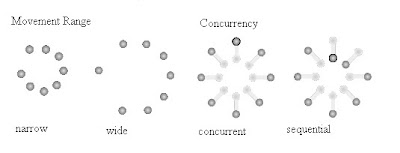Summary:
TYPERIGHT is a newly designed keyboard with pressurized key entry variable resistance that helps prevent users from entering keys that would lead to misspelled words or incorrect grammar. The authors goal was to implement a preventative method to incorrect typing that would hopefully increase the users efficiency in the long run compared to after-the-fact correction like spell checking and/or highlighting of possible mistakes. They compared their method to that of Apple's iPhone, in that like the iPhone's ability to minimize/enlarge keys to prevent mistyping, their keyboard would make keys harder to press that would lead to incorrect spelling or grammatical mistakes.
The actual design of the keyboard implemented solenoids that when activated created a magnetic resistance for their associated key. Therefore if a user tried to press a key that would lead to a mistake, he would face an increased resistance in the key. Below are a couple of screenshots showing the top layer of the keyboard, followed by a cut-out picture that shows the interaction of the solenoids.

Figure 1. TYPERIGHT: Full-keyboard prototype.

Figure 2. TYPERIGHT: Cross section of a key. The solenoid controls key resistance.
The authors conducted a user study in which they tested the performance of an after-the-fact correction method to their TYPERIGHT keyboard. In their study with novice users, the results showed that 'on average, the number of backspace key presses was reduced by 46% in the tactile feedback condition' and 'tactile feedback reduced the number of mistyped letters by 87%'. However in terms of efficiency the results showed that 'Average execution times were similar in both conditions (522 s with tactile feedback vs. 520 s with graphical feedback).' and 'Questionnaires confirmed that 75% of participants did not consider TYPERIGHT to be
a “big changeover compared to typing on a standard keyboard”'.
The authors also did one run with an expert user who had practiced the TYPERIGHT keyboard over a 3-month period and the results of his efficiency test were much better:
'The execution time with the first text was 10% faster than with the second text with graphical feedback. With tactile feedback activated, 16 corrections were necessary, compared to 23 corrections with graphical feedback (a 44% increase). With graphical feedback, the user typed 78 words that were not part of the dictionary, compared to zero(!) words with tactile feedback on the first text.' The authors indicated that this further confirms their indications that TYPERIGHT can effectively increase performance, but they also stated that they need further study with expert users to solidify their results.
Discussion:
Reading this paper made me think of the pressure sensitive keyboard from the UIST group. One of the major differences from this keyboard besides general function is that this one does not have a practical commercial model yet. Their design in this paper actually required a large modification to the keyboard in that they had to put solenoids between the keyboard and key caps for each key. One thing that wasn't covered in this paper was the comparison between TYPERIGHT and auto-correction, although the authors said that was a possibility for future work.






